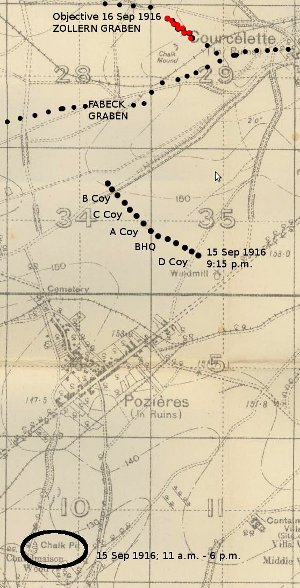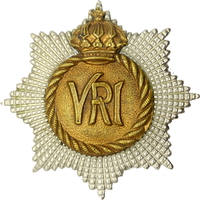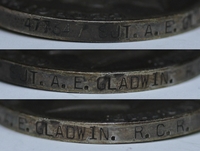
477347 A/L/Corporal Albert Edward Gladwin, M.M.
The Royal Canadian Regiment
By: Capt (ret'd) Michael M. O'Leary, CD, The RCR
Albert Gladwin was born at Bradford, Yorks, England, 26 Apr 1882. Having emigrated to Canada after 12 years service in the Royal Fusiliers, he enlisted in the Canadian Permanent Force (P.F.) with The Royal Canadian Regiment at Halifax, N.S., on 6 Dec 1913. Gladwin's P.F. Medical History form described him at the time as 31 years, seven months, of age, 5 feet 5 1/2 inches in height, and weighing 131 pounds.
Gladwin was assigned the regimental number was 9761. As a pre-War soldier of the Regiment, Gladwin is shown on the November 1914 nominal roll of the Regiment in Bermuda as a Lance Corporal. It was while he was serving in Bermuda that he was confirmed in the rank of Corporal on 1 Feb 1915.
After the Regiment's garrison service in Bermuda, it returned to Halifax for a few weeks before sailing for Europe. While in Halifax, there was a requirement to re-attest all soldiers of The RCR for overseas service with the Canadian Expeditionary Force. This was a result of concerns over the applicability of their Permanent Force enlistments for war service overseas. Accordingly, on 25 Aug 1915, Albert Gladwin signed a CEF attestation form in preparation for sailing across the Atlantic. The P.F. soldiers serving in the Regiment, although attested for the "Duration of the War" in the CEF, also had to periodically re-engage in the P.F. every three years during the war as their P.F. enlistments expired. The day after his attestation paper was signed, Gladwin and The RCR sailed from Halifax to continue their participation in the war, this time in Europe. Soon after arriving overseas, The RCR adopted its new service number block and Gladwin's regimental number would later change to the new CEF service number 477347.
While the Regiment was in England, Corporal Gladwin managed to find himself on the wrong side of the King's Regulations and Orders. On 8 Oct 1915 he was charged and punished "For absence from 12.01 a.m. 4 Oct 1915 until 10.35 p.m. 7 Oct 1915" and awarded a punishment of "Mulct Pay; 4 days," thus depriving him of the pay he had earned during his time away from the unit. Of the possible range of punishments, Gladwin was probably lucky that he did not lose his stripes.
Gladwin crossed the Channel to enter the theatre of war, France, on 2 Nov 1915. He served through the Regiment's first months in the trenches over the winter of 1915-16 and was admitted to No. 4 Canadian Field Ambulance with influenza on 8 Mar 1916. Three days later Gladwin was transferred to the Divisional Rest Station, Locre, and then discharged to duty on 12 Mar 1916.
A few months after his return to the Regiment from hospital, Corporal Gladwin was granted 8 days leave of absence from 29 May 1916, which was extended to 7 Jun, possibly to account for delays in his returning travel. While he was on leave, the date from which Gladwin's promotion to Sergeant would be effective passed. Although it would not be published in the Regiment's Daily Orders until 21 Jul 1916, his promotion was effective from 1 Jun 1916. On the regimental establishment, he replaced Sgt L.F.G. Bole who was commissioned in the Regiment.
Sergeant Gladwin would continue to serve in the field with The RCR and during September 1916, he would distinguish himself on the battlefield in the actions leading up to the assault on Zollern Graben. The following narrative is taken from the first volume of the regimental history of The RCR:

Approximate locations and movements of The RCR, 15-16 Sep 1916. Map extract from the online maps available through the McMaster University First World War map collection website.
At 7.30 o'clock on the morning of September 16, Lieut.-Col. Hill moved his Headquarters to a dugout in a trench called Centre Way, whence, at 1 p.m., he was called to Brigade Headquarters and given orders for a continuation of the attack of the previous day. In this new operation, The Royal Canadian Regiment was to attack Zollern Graben on the right, while the 42nd Battalion attacked on the left. As a preliminary, the Patricias and the 49th Battalion were to bomb the Germans out of the section of Fabeck Graben to which they still clung after the action of the previous night. This the two battalions promptly accomplished.
Meanwhile, Lieut.-Col. Hill had decided that his attack would be carried out by "D" Coy., under Major H.T. Cock, and "A" Coy., under Lieut. R. B. Penniman, with "C" Coy. in Battalion Support in Sugar Trench, and "B" Coy., extended to a full battalion frontage in the old Australian front line, as Battalion Reserve. The attacking companies were ordered to launch their assault from Fabeck Graben at 5 p.m. and were informed that a barrage would be laid on Zollern Graben at 4.40 p.m. Reconnaissances of the best routes to the attacking positions were meanwhile carried out under heavy fire, Privates A. E. Foster and B. McColl rendering in this work services of the greatest value.
Moving off from the reserve positions at approximately 3.30 p.m., the attacking companies came under heavy rifle and machine-gun fire, which harassed them as they covered the 1,500 yards to their jumping-off positions and inflicted heavy losses. Despite the measure of disorganization that resulted, the companies reached Fabeck Graben eventually and, having established contact with the 42nd Battalion on the left, tensely awaited the crash of the supporting barrage.
As arranged, the barrage was to have fallen on Zollern Graben at 4.40 p.m., but at this hour there was no sign of the concentrated shelling that had been expected. Minute after minute then passed, each an eternity to the men of The Royal Canadian Regiment and their Highland comrades on the left, who realized that, unless the barrage struck heavily on the objective before the attack at 5 p.m., death and disaster in No Man's Land inevitably awaited them.
At last, not long before zero, the barrage fell, but it was feeble and burst for the most part beyond the Canadian objective, leaving the strong garrison of Zollern Graben almost unaffected. The shelling probably impeded reinforcements, which were said to be approaching the German position from the rear, but the Canadians read in the failure of the shells to strike on Zollern Graben a message pregnant with disaster.
Grimly, therefore, the men prepared to attack; and at 5 p.m., on a given signal, they climbed over the parapet and moved forward. It was a gallant effort, gallantly led, but, as had been foreseen, it failed completely. Before it had advanced a dozen yards, the enemy lined the parapet of Zollern Graben and poured into it a devastating blast of rifle and machine-gun fire. Despite this, the attack, led with conspicuous bravery by Major H. T. Cock, with Sergt. T. O'Connor and Sergt. A. E. Gladwin rendering notable assistance, drove forward for 75 yards to a point approximately 150 yards from the objective. Beyond this, no further advance was possible and the remnant of the attacking waves recoiled to the positions whence they had come, many of the casualties owing their lives to
Private C. McGrath and Private J. Dawson, who toiled in rescuing the wounded with great devotion. On the left, the 42nd Battalion suffered a similar check. The waves of its attack lapped almost to the Zollern Graben, but no penetration of the objective could be effected. Meanwhile, upon the failure of the frontal attack, Lieut. R. B. Penniman moved to a point where the Regimental bombers and bombers of the Patricias were attacking along Zollern Graben from Fabeck Graben. This attack shattered a German machine-gun post, which had been effective in opposing the Canadian advance, and thereby cleared an obstacle from the path of the battalions destined to take over the front line.
Late that night, or rather before dawn on September 17, elements of these units, the 52nd and 60th Battalions, arrived in the forward area and relieved the attacking and support companies of the Regiment, which thereupon withdrew to bivouacs at Tara Hill. They also relieved "B" Coy., which, after the attack, had advanced under heavy fire to a position some sixty yards in rear of Fabeck Graben, under the command of Capt. H. M. Logan, whose capable leadership was later recognized by a Mention in Despatches.
At Tara Hill, after the weary companies and details had reported in, a check of losses in the engagement showed that Lieut. G.L. Lewis had been killed, that Major H. T. Cock, Capt. N.E. Towers, Lieut. L.A. Naylor, and Lieut. W.G. Wurtele had been wounded -- Capt. Towers so severely that he died later of his wounds -that Lieut. S.C. Bate and Lieut. R.B. Penniman had been wounded, but were at duty, and that 264 other ranks were killed, wounded, or missing. Despite a draft of 110 other ranks, which reported from England on September 17, the Battalion, as it stood at Tara Hill that day, showed unmistakably the bitter effect of its first experience of battle on the Somme. - The Royal Canadian Regiment, 1883-1933, by R.C. Fetherstonhaugh, 1936, pages 249-251
Gladwin's participation in the attack would lead to a recommendation for an immediate award of the Military Medal which was approved within a few weeks of the event. Because it was an early (i.e., 1916) award of the Military Medal, the citation can be found in the records held by Library and Archives Canada. Approved by General Lipsett on 1 Oct 1916, Gladwin's citation reads:
"For conspicuous gallantry and bravery in leading his platoon in an attack on Sep 15th, 1916, from SUGAR TRENCH. On leaving the parapet where they were exposed to intense Rifle, Machine Gun, and Shell fire he fearlessly exposed himself and by his example of daring materially assisted in the advance."
"On reaching a position his Platoon had been subjected to many casualties and had become mixed with elements of other Regiments. He again displayed great bravery in the re-organization of his platoon which he successfully accomplished in a very short space of time."
The Regiment's War Diary entry for 5 Oct 1916 recorded the immediate award of the Military Medal to Sergeant Gladwin as well as awards to other Royal Canadians for actions at the Somme during the same tour in the trenches:
5-10-16. - TRENCHES.
Showery. Relief completed at 3.30 a.m. Battalion in bivouacs at TARA HILL. After resting all morning men started cleaning up in afternoon.
Total casualties during tour are Lieuts. HORTON, CHURCHILL, PITMAN and MACCONNELL Wounded and Lieut. STUART missing, 9 O.R. Killed, 15 O.R. Missing, 60 O.R. Wounded.
Sergts. T. O'CONNOR and A.E. GLADWIN, Scouts - A.E. FOSTER and B. MCCOLL, C.U. MCGRATH, awarded M.M. J. DAWSON awarded D.C.M.
But by the time Gladwin's Military Medal was noted in the Regiment's War Diary, he was back in England in hospital. A little more than a week after the mid-September action on the Somme, Gladwin would leave the Regiment, being admitted to No. 3 Canadian Stationary Hospital at Boulogne on with 25 Sep 1916 with myalgia. His condition was serious enough to merit evacuation to England, and on 29 Sep 1916 Sgt Gladwin was transferred to the Canadian Casualty Assembly Centre (CCAC) at Folkestone. He was evacuated across the Channel aboard the hospital ship H.S. St Denis. The following day he was admitted to the Military Hospital, Trent Bridge, Nottingham, and taken on the strength of the CCAC, Shoreham. He would be transferred to Moore Barracks, Shornecliffe, on 17 Oct 1916, and not discharged from hospital until the new year.
While he was in hospital, on 9 Dec 1916, Albert Gladwin's Military Medal was published in the London Gazette, Issue No. 29854. A month later, on 10 Jan 1917, he was discharged from Hospital and reported to CCAC, Hastings. At the time of his discharge, his medical file noted:
"This man has been in hospital for 13 weeks. He still complains of some pain in left leg. Appetite good. Appears fit. Recommended for light duty. Discharged to CCAC."
Although held on the strength of the CCAC, Gladwin was sent On Command to the Garrison Duty Depot. In early February 1917 he was attached to the Headquarters at Crowborough and posted to the General Duty Company, which would be effective until transferred to the Canadian Machine Gun Corps Regimental Depot on 16 Mar 1917.
Having left the Machine Gun Corps Depot, Gladwin would be taken in strength of the Nova Scotia Regimental Depot on 10 Apr 1917 and immediately sent on Command to the CMG Depot at Bramshott until the 29th of that month when he would return to the NSRD. A few days later, on 3 May 1917, he would be sent on command to the Canadian Records Office, London, and be formally transferred to the staff there on 20 Jul 1917.
Sergeant Gladwin would serve out the rest of the war on the staff of the Records Office. While working there he was admitted to Hospital for treatment of venereal disease on 29 Jul 1918. His medical records at the time note that he was previously treated for gonorrhoea in Mauritius in 1909. Earlier, in 1901, while serving in Cairo, he was treated for a chancre on his penis accompanied by rash and sore throat. Gladwin's medical case card for 1918 notes that he was at that time contemplating marriage and had noticed no recurrence since 1901. He was treated regularly for his affliction until 14 Feb 1919 at which time he refused further treatment. Shortly before refusing further treatment for venereal disease, on 4 Jan 1919, Gladwin commenced a Pay Assignment to his new wife; Mrs Kate S. Gladwin, 94 Bury St, Lower Edmonton, N4, London, on 4 Jan 1919
Gladwin was medically examined for his discharge from the CEF on 16 Jun 1919. The report noted that he was pale and suffering from tertiary venereal disease resulting in "slight weakness" but that he had refused further treatment while on military service. The report also noted that Gladwin "complains of pains in legs, especially before a change in the weather. He has been in hospital several times where a diagnosis of myalgia was made." The state of his disability at the time of his examination was attributed to "improper conduct" and "aggravated by refusal to accept further treatment." Although not noted on earlier documents, Gladwin's final medical examination described tattoos on his arms: a snake on the left forearm, and a dagger and memorial cross on his right forearm.
Albert Gladwin was discharged from the CEF at London, England, on 27 Jun 1919 on demobilization. For his services in the CEF, he would receive the British War Medal and the Victory Medal to accompany his Military Medal. Gladwin would also be issued the Class "A" War Service Badge, No. 225000.
His last recorded address in England was 94 Bury St, Lower Edmonton, London, N.G., England.
Pro Patria
Visit a randomly selected page in The O'Leary Collection (or reload for another choice):
- The O'Leary Collection; Medals of The Royal Canadian Regiment.
- Researching Canadian Soldiers of the First World War
- Researching The Royal Canadian Regiment
- The RCR in the First World War
- Badges of The RCR
- The Senior Subaltern
- The Minute Book (blog)
- Rogue Papers
- Tactical Primers
- The Regimental Library
- Battle Honours
- Perpetuation of the CEF
- A Miscellany
- Quotes
- The Frontenac Times
- Site Map
QUICK LINKS
The O'Leary Collection—Medals of The Royal Canadian Regiment
Newest additions:
![]()
![]() SB-12725 Private Henry "Hank" Ard
SB-12725 Private Henry "Hank" Ard ![]()
WIA at Hill 187, Died of Wounds in Japan
![]()
![]() 2355331 Lance Corporal Albert Lorking
2355331 Lance Corporal Albert Lorking
Wounded in action, later a War Amps representative.
![]()
![]() 4334 / 477996 Pte Isaac Hamilton Wilcox
4334 / 477996 Pte Isaac Hamilton Wilcox
Permanent Force, South Africa, and C.E.F.
![]()
![]() 477019 Private Harold Ashcroft
477019 Private Harold Ashcroft
Transferred to the Tunnelers.
![]()
![]() 734231 Private Clark D. Thompson
734231 Private Clark D. Thompson ![]()
The older Thompson brother, killed in action.
![]()
![]() 733849 Private Norman Parker Thompson
733849 Private Norman Parker Thompson
The younger Thompson brother; post-war service in the Special Guard.
![]()
![]()
![]() A305 / 400305 Private Andrew Walker
A305 / 400305 Private Andrew Walker ![]()
"Previously reported Wounded, now Killed in Action."
![]()
![]() 823298 Pte Thomas Patrick Steele, M.M.
823298 Pte Thomas Patrick Steele, M.M. ![]()
… for gallant conduct in the field …
![]()
![]() P13066 Sergeant Harold Thompson
P13066 Sergeant Harold Thompson
Instrumental Soloist for over 20 years of Canadian Army service.
![]()
![]() 9609 / 477728 Private Albert Edward Piper
9609 / 477728 Private Albert Edward Piper
"Arrived from England as a STOWAWAY …"


